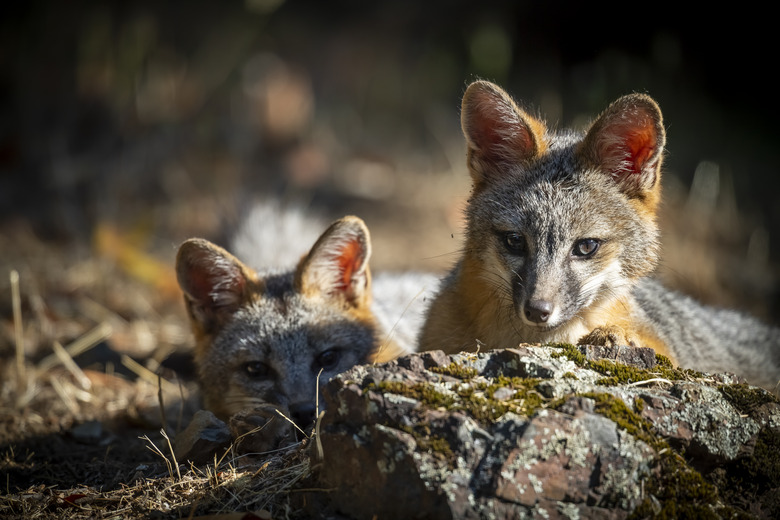What Do Gray Foxes Eat?
The gray fox (Urocyon cinereoargenteus) is an omnivore meaning that the grey fox diet consists of both eating animals and plants. These foxes eat whatever is palatable and available at the time.
Unique among the canines in that it regularly climbs trees, the gray fox has a range extending across most of the United States and southern parts of eastern Canada, as far south as Colombia in South America. Only portions of the Great Plains and the mountains of the northwestern states lack the presence of this species of fox.
Grey Fox Diet Depends on Seasonal Foods
Grey Fox Diet Depends on Seasonal Foods
Wildlife biologist James Masek, writing for Alabama Outdoors, notes that the gray fox diet in the summer includes more vegetarian foods than it does in winter. In summer, the gray fox devours such foods as blackberries, corn, grasshoppers, persimmons, crickets and acorns. As fall approaches, it will eat all sorts of nuts.
In the winter, small mammals comprise the bulk of the diet. The gray fox eats squirrels, rats and rabbits, along with mice and voles, when the weather turns colder. Abundant supplies of food translate into the gray fox being heavier than normal, since it takes advantage of the opportunities that present themselves.
Habits
Habits
The gray fox is stealthy and people seldom see it. One reason is that it does the majority of its hunting and foraging for food at night. The gray fox restricts its activity mostly to brushy areas when it looks for a meal.
The gray fox climbs trees as well. It actually hunts in them for creatures such as birds, eating any eggs they find in the nests they encounter. If a particular habitat has enough food to support their numbers, gray foxes do not wander far from their place of birth, often living within a mile of it.
Hunting Technique
Hunting Technique
The young gray fox is ready to hunt by the time it turns 4 months old when it is weaned off its mother's milk. When hunting for food, the gray fox does not use its acute sense of smell to track animals down.
Instead, the fox walks around and listens for any sounds and scents indicating a small creature is close by. Once they identify a potential target, the gray fox will then stalk the prey, pouncing upon it when it gets close enough.
Grey Fox Facts: Pros and Cons
Grey Fox Facts: Pros and Cons
The benefit of a gray fox in the environment is that the canine keeps the number of rodents in the area under control. For example, by killing and eating such pests as the cotton rat, a common southern rodent, the gray fox helps the quail population thrive since cotton rats prey upon the eggs of quail.
However, the gray fox is also a predator of quail and their nests, as well as other game birds such as grouse, wild turkeys and pheasants. In rare instances, notes the National Trappers Association, a gray fox will poach a chicken from a barnyard.
Red Fox and Grey Fox Diet Similarities
Red Fox and Grey Fox Diet Similarities
It's easy to misidentify the grey fox as the common red fox (Vulpes vulpes) as they look extremely similar and have many of the same behaviors, habitats and diets. The red fox is found all over the United States and Canada except for some parts in the southwestern United States.
Like the grey fox, the red fox is an omnivore and often switches the general diet based on the seasonality of their region and the available food sources. They'll eat berries, nuts, fruit and grass when prey is not available. The red fox will also often eat caterpillars, crayfish, grubs, beetles and other invertebrates.
Cite This Article
MLA
Lindell, John. "What Do Gray Foxes Eat?" sciencing.com, https://www.sciencing.com/do-gray-foxes-eat-8497562/. 22 November 2019.
APA
Lindell, John. (2019, November 22). What Do Gray Foxes Eat?. sciencing.com. Retrieved from https://www.sciencing.com/do-gray-foxes-eat-8497562/
Chicago
Lindell, John. What Do Gray Foxes Eat? last modified March 24, 2022. https://www.sciencing.com/do-gray-foxes-eat-8497562/
